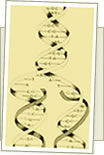EVOLUTIONARY INFORMATICS
Evolutionary informatics merges theories of evolution and information, thereby wedding the natural, engineering, and mathematical sciences. Evolutionary informatics studies how evolving systems incorporate, transform, and export information. The Evolutionary Informatics Laboratory explores the conceptual foundations, mathematical development, and empirical application of evolutionary informatics. The principal theme of the lab’s research is teasing apart the respective roles of internally generated and externally applied information in the performance of evolutionary systems.
INFORMATION & DESIGN
Intelligent design is the study of patterns in nature best explained as the product of intelligence. So defined, intelligent design seems not problematic. Archaeology, forensics, and the search for extraterrestrial intelligence (SETI) all fall under this definition. In each of these cases, however, the intelligence in question could be the result of an evolutionary process. But what if patterns best explained as the product of intelligence exist in biological systems? In that case, the intelligence in question would be an un-evolved intelligence. For most persons, such an intelligence has religious connotations, suggesting that it as well as its activities cannot properly belong to science. Simply put, intelligent design, when applied to biology, seems to invoke ‘spooky’ forms of causation that have no place in science. Evolutionary informatics eliminates this difficulty associated with intelligent design. By looking to information theory, a well-established branch of the engineering and mathematical sciences, evolutionary informatics shows that patterns we ordinarily ascribe to intelligence, when arising from an evolutionary process, must be referred to sources of information external to that process. Such sources of information may then themselves be the result of other, deeper evolutionary processes. But what enables these evolutionary processes in turn to produce such sources of information? Evolutionary informatics demonstrates a regress of information sources. At no place along the way need there be a violation of ordinary physical causality. And yet, the regress implies a fundamental incompleteness in physical causality’s ability to produce the required information. Evolutionary informatics, while falling squarely within the information sciences, thus points to the need for an ultimate information source qua intelligent designer.
RESEARCH TOOLS
Weasel Ware
A web-based simulation of Dawkins’ Weasel. Do the mere presence of replication, mutation and selection guarantee success in a search? If not, what fraction of all possible fitness functions lead to success? How likely are we to stumble across a successful fitness function if we initialize one at random? The free simultation lab allows users to answer these questions and more. Simply set up your experiment, choose (or optionally design) your fitness function and record your results.
Minivida
Minivida is a simplified, online simulation of Lenski et. al.’s Avida. It allows the evolution and visualization of NAND-logic programs. With it, you can learn how the choice of rewarded tasks and instructions affects the ability of locating EQU operations. Does the process of mutation and selection alone allow the evolution of complex operations or is the presence of stair step information necessary in order to guide the process? Run the simulation and see what role user-supplied information plays in the discovery of complex features.
Ev Ware
A javascript implementation of Tom Schneider’s ev, with several modes and upgrades. Allows for real-time, multi-run evolution experiments. With Ev Ware, you can test and limit how much information is imposed on the search by the structure of the program and by particular parameter settings. Discover how likely randomized initializations are to stumble upon targets of your choice. Does ev create information from “scratch” or does it merely reshuffle pre-supplied information? Find out.
FEATURED PUBLICATIONS
- The Search for a Search: Measuring the Information Cost of Higher Level SearchWilliam A. Dembski and Robert J. Marks II
- LIFE’S CONSERVATION LAW: Why Darwinian Evolution Cannot Create Biological InformationWilliam A. Dembski and Robert J. Marks II
- Conservation of Information in Search: Measuring the Cost of SuccessWilliam A. Dembski and Robert J. Marks II
- Bernoulli’s Principle of Insufficient Reason and Conservation of Information in Computer SearchWilliam A. Dembski and Robert J. Marks II
- Evolutionary Synthesis of Nand Logic: Dissecting a Digital OrganismWinston Ewert, William A. Dembski and Robert J. Marks II
- A Vivisection of the ev Computer Organism: Identifying Sources of Active InformationGeorge Montañez, Winston Ewert, William A. Dembski and Robert J. Marks II
- A Second Look at the Second Law Granville Sewell



